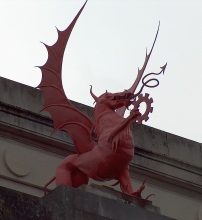
Victorian and Edwardian sculpture of dragons is prolific across Britain, in both free-standing statues and as architectural adornment. Perhaps the most frequent specific type is in St George and the Dragon groups, but those are the subject of a separate page. Here we look at a range of other dragon sculpture types we can encounter.
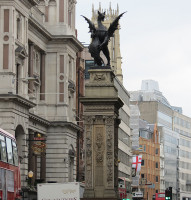
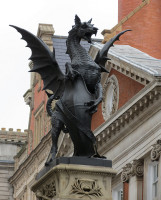 The Temple Bar dragon sculpture, City of London, by C. B. Birch.
The Temple Bar dragon sculpture, City of London, by C. B. Birch.
The best known dragon sculptures that leap to mind are the City of London dragons, and the Welsh dragons. The City of London coat of arms features a dragon, and free-standing dragon statues may be found on boundaries to the Square Mile. Probably the best of breed is that at Temple Bar, between Fleet Street and the Strand, on top of the Temple Bar Monument (described on this page). This great bronze creature is a traditional dragon, with a powerful body, sharply taloned hind and forepaws, two batlike wings, a tail with an arrow point, and most evocative of all, a spiky, toothy head, fierce and reptilian. This splendid work is by the sculptor C. B Birch.
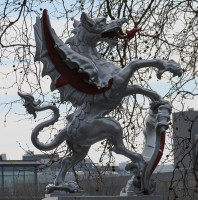 One of the London Coal Exchange dragons.
One of the London Coal Exchange dragons.
Another familiar pair in London, actually rather physically close to the Temple Bar dragon, are the City Dragons on the Victoria Embankment, again marking the City boundary. They come from the London Coal Exchange, demolished by the barbarians in the 1960s. Again we see an upward rearing conventional dragon, winged and with curled, arrow-ended tail, and heavily-toothed jaws. The treatment here is heraldic and thus conventional rather than naturalistic, with a formal rearing pose, and one paw holding up the City shield. We may note the body is rather horselike, and the claws rather lion-like, so this is a rather griffinlike creature overall. A good example of the type.
Views of Cardiff City Hall dragon statue, by H. C. Fehr.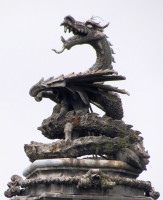
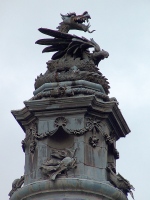
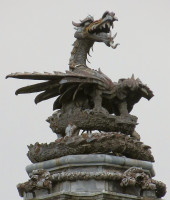
The grandest of Welsh dragon statues is that on top of Cardiff City Hall, a huge beast, with a long, serpentlike body coiled round upon itself, small legs, wings, and incredibly spiky – the inspiration is a Chinese rather than Western dragon. The sculptor was H. C. Fehr, a master of the turn-of-the-century New Sculptors movement.
Cardiff abounds with other good dragon sculpture. Above left, a particularly nicely poised dragon statue on a summit spike, about to fly down on its prey. Then a pair of guard-dragons, with bodies like greyhounds, birdlike talons, extremely batlike wings, and nothing particularly reptilian about them at all. Next, a small iron dragon statue, one paw raised, more conventional in type. And the red one at the end is a sort of horizontal caryatid, forming a supporting base. Something between the griffin-like and the bird-like in nature, and with a sour expression and a medieval spirit. The red dragon statue at the top of this page is another Welsh one.
Dragon sculpture on the small scale as architectural corbels. 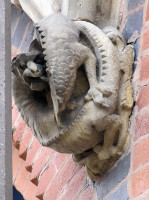
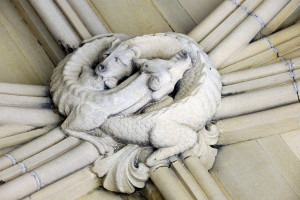
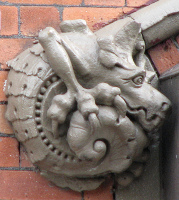
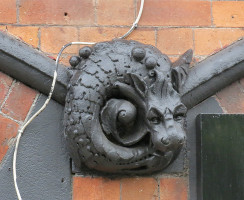
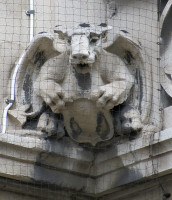
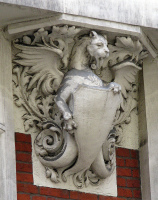
On a small scale, one of the nicest types of dragon is the long and thin type wound into a ball to form an architectural ornament or corbel. They often work best in pairs, as in the two examples above left. The next two show single dragons curled up, the fourth being particularly satisfactorily wound up, and the second supports the horn on his back, wing, and shoulder. Then a different type of globular ornament, with the dragon facing straight out from a corner, heavy claws grasping a small shield, wings open to enhance the overall roundness. The one to the far right above is a particularly large example, rather snub nosed, with the wings among foliage to make a substantial support for the mass above.
Dragon sculpture on small scale as structural supports. 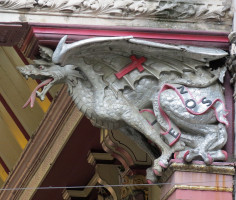
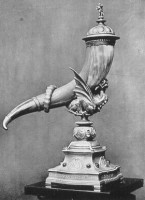
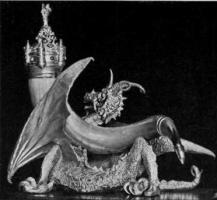
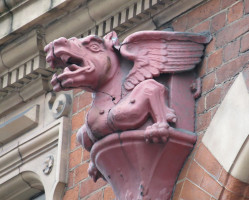
More of these rather flattened creatures. Above left, a dragon stretching forward from his narrow plinth to form a long bracket supporting a superstructure. He has the cross of St George on his wing. Next, two drinking horns supported on small dragons; the first curls up his head and elevates his wings to act as a clasp for the horn, extra support being provided by the chameleon-like tail wound round the narrowing vessel. The little dragon above right acts as the ornamental top of a drainpipe, and has a head rather like that of a hippopotamus.
Back to the corbels, with further variations on these small rounded dragon sculptures. Above left, an example from well into the 20th Century showing a square rather than round design, but again with the dragon carved as coiled up to fill the available space, in this case with long body but no neck at all. Next, a rather conventional dragon, much worn but still fierce in aspect, with a narrower bulk so that it is more of a bracket than a corbel. The third example above is a rather inspired bit of carving, as if the small beast had just found a spot to alight on the side of a building, and was clinking on with its claws. And a little dragon, extremely weathered, in a more rectangular composition, neck turned back so the head regards its own wing.
Dragons in high relief set in spandrels.
Dragons carved in relief on panels next. We start above left with a pair of grotesque dragons by a shield, their tails turning to leafy appendages, the heads and necks serpentine and captivatingly twisted. Next, another grotesqued dragon carved in a spandrel. The appeal of this beast is the leafy appendages behind head and neck. And above right another spandrel relief sculpture featuring a bearded dragon of medieval style, with a long furry tail. This is from the famous Erpingham Gate by Norwich Cathedral. (For other spandrel carving, see this page)
Snakelike dragon sculptures, without legs. 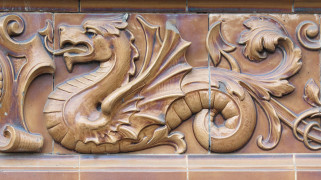
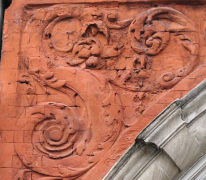
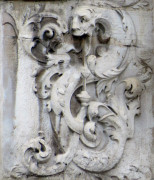
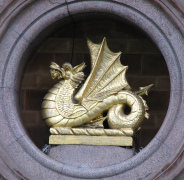
Commonly, these high relief carvings of dragons in panels have just two legs, or none, to accompany the wings. A terra cotta example is above left, showing the archetypical snakelike dragon, with conventional head, batlike wing, arrow-tipped tail, and S-shaped coil to the body. Next, a spandrel with long, snakelike dragon, with the visible wing reduced to vestigial size. Next, a rather similar S-shaped dragon with even smaller wings, almost lost among the acanthus. This one is made in brick. The fourth example, another spandrel, has the dragon’s tail in the long end of the spandrel, and the body curling round to fill the large right angle. And on the right hand side, a free-standing sculpture in the round of one of these S-curved dragon snakes, with a good outline and a harmony between the round coil of the tail and the span of the wing.
Summit dragon sculptures made in terra cotta and stone. 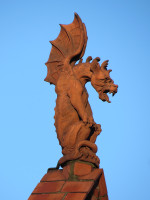
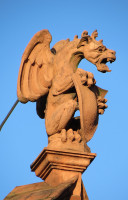
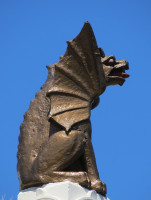
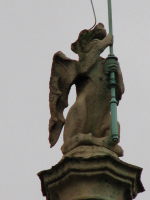
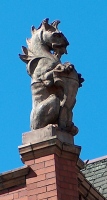
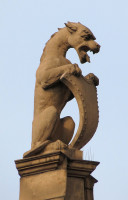
Dragons are the perfect sculptural adornment for the summit of a building. Above left, two examples of a rather common type on terra cotta buildings of the 1890s or thereabouts, aiming to give a strong silhouette against the sky, and having a heraldic nature. A variation is the dark-painted sculpture in the centre, with rather more of a gargoyle aspect. It dates from about 1895. Then a small upright dragon holding a flagpole, much worn, and with the loss of the teeth, an almost dog-like look. Next, another terra cotta one, with the emphasis on the spiky neck rather than head or vestigial wing. And another heraldic beast, completely wingless but still recognisably a dragon, with a bent triangular shield. This one is in Oxford Street (see this page).
A particular variant on the summit dragon is the weathervane. Above left, a Loch Ness Monster type of dragon, winged but clearly aquatic in its habits, on top of a tavern. And above right the enormous St Mary Le Bow steeple dragon, a beast measuring some 9ft from head to tail. Note again the St George’s Cross under the wing.
Dragon statues standing erect. 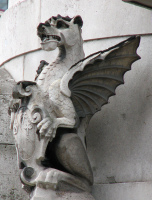
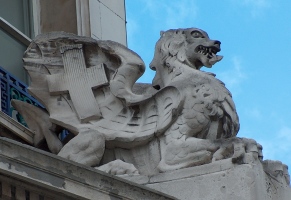
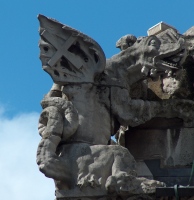
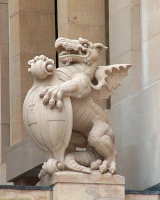
Here, we bring the dragon off the summit, but retain a free-standing erect dragon sculpture. Above left, a Portland stone dragon with nicely carved wings, and a coat of arms. Next, a very lionlike dragon - if he had an eagle’s head he would make a good griffin – one of several on the vast Smithfield Market building. The sculptor of these dragons was C. S. Kelsey. Among the most evocative of this style of dragon – perhaps the model used by Kelsey – are the much earlier dragon sculptures on the Monument to the Great Fire, also shown above. The powerful bearlike body, the restlessly coiling tail, the play of muscles on haunch and neck, make this a masterpiece. Then a rather squat beast, again heraldic, with hairy face and eyebrows giving a gleefully evil expression. All these last have crosses on their wings and represent dragon types of the City of London.
Victorian dragon sculptures with gargoyle character. 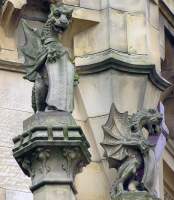
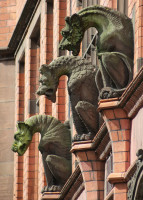
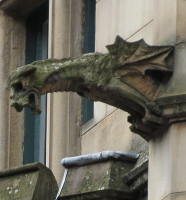
I did not want this page to be about gargoyles, which is a different field of sculpture more associated with medieval churches than Victorians and Edwardians, but here are a couple of 19th Century dragons tending to the gargoyle. Above left, two squatting beasts with laconic expression and curved necks. Then part of a row of gargoyle dragons perched on the frontage of a Liverpool building in Victoria Street called the Carlisle Buildings. The third example above is another gargoyle type, with the dragon protruding straight out from the vertical wall, as often used in medieval times to channel water away from the sides of the building.
There is a separate page on St George and the Dragon, but I wanted to end with a few examples of other groups incorporating a dragon. Above left is the Exeter War Memorial figure of Victory astride a dragon, by the sculptor John Angel. The roundel next to it shows a girl seated on a a pair of snakelike dragons with small wings; the dragon reduced to a beast of burden. Next, two of WJ Neatby’s terra cotta groups of men fighting with coiling dragons, whose wings wrap around their antagonists – these are on a building in Newhall Street, Birmingham. Then a high relief sculpture of Perseus, head of the Medusa in hand, mighty sword plunged into the head of a lizardlike dragon whose aspect is rather similar to that of the Exeter War Memorial dragon. And a group above a portico in Cornhill, London, with a conventional dragon sculpture as a supporting character to the two central girls.
Visits to this page from 13 Mar 2014: 2,011 since 9 March 2025
Mermaid sculpture // Unicorn sculpture // Phoenix sculpture // Sphinx sculpture // Animal sculpture // Allegorical sculpture
St George and the Dragon statues